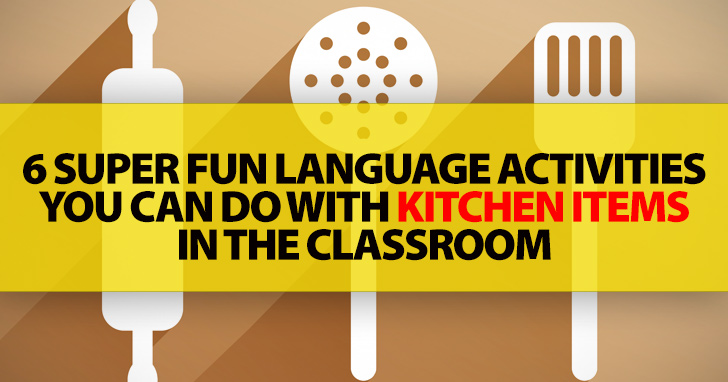Do This! Donít Do That! 8 Interactive Classroom Activities for Using the Imperative


My students have fun sharing their food and culture, and eating what I and their classmates prepare, and it creates a relaxing atmosphere in class. When we cook, though, we cook with a purpose. I always have language activities linked to our culinary forays. Cooking may not be right for every ESL teacher, but it’s super simple to bring in a few kitchen items to use in class. And you’d be surprised at how many activities you can do with items that are just sitting around your kitchen. Here are some activities you can do with simple kitchen items, even if you are not a gourmet, that will also make memorable activities for your ESL students.

Whether you have cookbooks at home or you go online when you need to find culinary instructions, any recipe is great for sequencing in the ESL classroom. Make copies for your students (white out any numbers on the cooking instructions), cut apart the steps in the cooking process, and have students work independently or with a classmate or two to sequence the steps in the recipe. You don’t have to use a complicated recipe, and you might even want to write out a few simple steps for a recipe of your own. Try writing instructions on how to make a peanut butter and jelly or grilled cheese sandwich, cut out instructions from a box of baking mix on how to make pancakes, or copy a more complicated recipe from any cookbook you have at your disposal. When they sequence the steps, your students will get practice with reading comprehension and logical ordering as well as exposure to new vocabulary.
When it comes time to review prepositions with your students, you can have a lot of fun with just a few bowls and a small kitchen item like a spoon or timer. Simply bring your items into class, set up a table at the front of the room, and put the objects in different arrangements to review or test your students’ knowledge of prepositions. (Put the bowl over the spoon, the spoon in the bowl, the bowl next to the spoon, etc.) You might even want to have students copy your setups with a few props of their own. Try giving each student one or more plastic cups and the cap from a milk bottle, and have them recreate your preposition demonstrations on their own desks. Stop after each arrangement for students to tell a partner about their set up, using prepositions of course, or for students to write a sentence about their objects. (E.g. The large cup is over the milk cap.)
In addition to reviewing prepositions with your students, you can use these times to practice comparative and superlative adjectives. Have students make sentences that compare their objects or those you are demonstrating with up front. They might talk about objects that are bigger, rounder, more colorful, or more useful than others.
The most obvious use of kitchen items in the classroom is teaching cooking related vocabulary. Bring in items on your vocabulary list, and let students handle them and examine them. If you are teaching a group of internationals, they might be interested in seeing the differences between items they have at home and those that Americans have at home. (For example, you might use a fork where they might use chopsticks.) Don’t limit your vocabulary lesson to nouns, however. Show your students how to use the items you brought in, and you can get a good collection of verbs in your vocabulary lesson. Try teaching words like mix, fry, chop, turn, test, and let cool. Then let your students take turns acting out the verbs with the items you bring in.
Because food is such an integral part of culture, bringing in kitchen items will naturally lead into a discussion of cultural differences. If you can, bring in some items and prepare a favorite dish for your students (as always being allergy sensitive). Tell your students when you traditionally prepare that dish and what memories it evokes. If you like, invite your students to share a favorite item of theirs with the class as well. I have had great success with students giving informational presentations by demonstrating how to cook a favorite dish. My students’ favorite part is eating the food their international classmates prepare. If you’re not one for cooking, you can still do this activity. Just describe the food (a great chance to practice descriptive language) and let students share about theirs.
If you teach young ESL students, you know how important imaginative play is for children. Give them something interesting to use for their pretend play by bringing in empty boxes and containers from your kitchen. Simply tape empty boxes closed and put your props in a corner of your classroom. Students will love playing with these items during free play time, and they will be using kitchen vocabulary without even realizing it.
Don’t teach young students but still want to bring kitchen items in? Have students use them for a role play. Have students play roles at a restaurant, in a family, or at a supermarket. Give each person a goal for their role play that is in conflict with the other person’s goal and watch them negotiate for a solution while having fun with your props.
As ESL teachers, we are always trying to get our students to use descriptive and specific language. It’s not too hard to have students describe what they see or hear in your classroom, but how often can they taste the items normally around them in class? Bring in a few foods (as always being allergy sensitive) and you have a great opportunity to use words like bitter, sweet, tangy, bland, spicy, salty, and others. To make the activity even more entertaining, have one person come to the front of the room and put on a blindfold. Then have them taste a food item and describe what it tastes like.
You don’t have to be a great cook to see how beneficial kitchen items can be for your students and your classroom. If you want to give it a try, see what you have hanging around the kitchen, bring it in, and a language lesson will practically create itself.
What are your favorite activities to do with them?